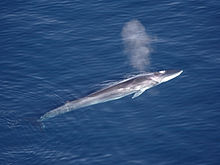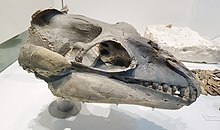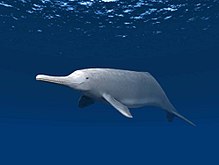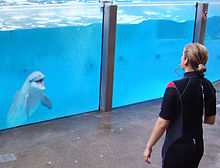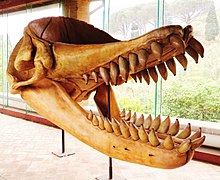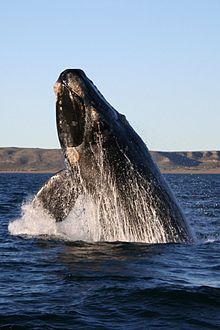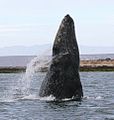Portal maintenance status: (February 2020)
|
The Cetaceans Portal

Cetacea (/sɪˈteɪʃə/; from Latin cetus 'whale', from Ancient Greek κῆτος (kêtos) 'huge fish, sea monster') is an infraorder of aquatic mammals belonging to the suborder Whippomorpha that includes whales, dolphins and porpoises. Key characteristics are their fully aquatic lifestyle, streamlined body shape, often large size and exclusively carnivorous diet. They propel themselves through the water with powerful up-and-down movement of their tail which ends in a paddle-like fluke, using their flipper-shaped forelimbs to maneuver.
While the majority of cetaceans live in marine environments, a small number reside solely in brackish water or fresh water. Having a cosmopolitan distribution, they can be found in some rivers and all of Earth's oceans, and many species inhabit vast ranges where they migrate with the changing of the seasons.
Cetaceans are famous for their high intelligence, complex social behaviour, and the enormous size of some of the group's members. For example, the blue whale reaches a maximum confirmed length of 29.9 meters (98 feet) and a weight of 173 tonnes (190 short tons), making it the largest animal ever known to have existed.
There are approximately 89 living species split into two parvorders: Odontoceti or toothed whales (containing porpoises, dolphins, other predatory whales like the beluga and the sperm whale, and the poorly understood beaked whales) and the filter feeding Mysticeti or baleen whales (which includes species like the blue whale, the humpback whale and the bowhead whale). Despite their highly modified bodies and carnivorous lifestyle, genetic and fossil evidence places cetaceans as nested within even-toed ungulates, most closely related to hippopotamus within the clade Whippomorpha. (Full article...)
 Recognized content - load new batch
Recognized content - load new batch 
-
Image 1Cetacea is an infraorder that comprises the 94 species of whales, dolphins, and porpoises. It is divided into toothed whales (Odontoceti) and baleen whales (Mysticeti), which diverged from each other in the Eocene some 50 million years ago (mya). Cetaceans are descended from land-dwelling hoofed mammals, and the now extinct archaeocetes represent the several transitional phases from terrestrial to completely aquatic. Historically, cetaceans were thought to have descended from the wolf-like mesonychians, but cladistic analyses confirm their placement with even-toed ungulates in the order Cetartiodactyla.
Whale populations were drastically reduced in the 20th century from intensive whaling, which lead to a moratorium on hunting by the International Whaling Commission in 1982. Smaller cetaceans are at risk of accidentally getting caught by fishing vessels using, namely, seine fishing, drift netting, or gill netting operations. (Full article...) -
Image 2
The fin whale (Balaenoptera physalus), also known as the finback whale or common rorqual, is a species of baleen whale and the second-longest cetacean after the blue whale. The biggest individual reportedly measured 26 m (85 ft) in length, with a maximum recorded weight of 77 to 81 tonnes. The fin whale's body is long, slender and brownish-gray in color, with a paler underside to appear less conspicuous from below (countershading).
At least two recognized subspecies exist, one in the North Atlantic and one across the Southern Hemisphere. It is found in all the major oceans, from polar to tropical waters, though it is absent only from waters close to the pack ice at the poles and relatively small areas of water away from the open ocean. The highest population density occurs in temperate and cool waters. Its prey mainly consists of smaller schooling fish, small squid, or crustaceans, including copepods and krill. Mating takes place in temperate, low-latitude seas during the winter. Fin whales are often observed in pods of 6–10 animals, with whom they communicate utilizing frequency-modulated sounds, ranging from 16 to 40 hertz. (Full article...) -
Image 3
The sei whale (/seɪ/ SAY, Norwegian: [sæɪ]; Balaenoptera borealis) is a baleen whale. It is one of ten rorqual species, and the third-largest member after the blue and fin whales. It can grow to 19.5 m (64 ft) in length and weigh as much as 28 t (28 long tons; 31 short tons). Two subspecies are recognized: B. b. borealis and B. b. schlegelii. The whale's ventral surface has sporadic markings ranging from light grey to white, and its body is usually dark steel grey in colour. It is among the fastest of all cetaceans, and can reach speeds of up to 50 km/h (31 mph) over short distances.
It inhabits most oceans and adjoining seas, and prefers deep offshore waters. It avoids polar and tropical waters and semi-enclosed bodies of water. The sei whale migrates annually from cool, subpolar waters in summer to temperate, subtropical waters in winter with a lifespan of 70 years. It is a filter feeder, with its diet consisting primarily of copepods, krill, and other zooplankton. It is typically solitary or can be found in groups numbering half a dozen. During the breeding period, a mating pair will remain together. Sei whale vocalizations usually lasts half a second, and occurs at 240–625 hertz. (Full article...) -
Image 4Skull of Janjucetus hunderi at the Melbourne Museum
Janjucetus is an extinct genus of cetacean, and a basal baleen whale (Mysticeti), from the Late Oligocene around 25 million years ago (mya) off south-east Australia, containing one species J. hunderi. Unlike modern mysticetes, it possessed large teeth for gripping and shredding prey, and lacked baleen, and so was likely to have been a predator that captured large single prey animals rather than filter feeding. However, its teeth may have interlocked, much like those of the modern-day filter-feeding crabeater seal (Lobodon carcinophaga), which would have allowed some filter-feeding behaviour. Its hunting behaviour was probably similar to the modern-day leopard seal (Hydrurga leptonyx), probably eating large fish. Like baleen whales, Janjucetus could not echolocate; however, it did have unusually large eyes, and so probably had an acute sense of vision. The only specimen was found on the Jan Juc beach, where the remains of the extinct whales Mammalodon, Prosqualodon and Waipatia have also been discovered. (Full article...) -
Image 5

The false killer whale (Pseudorca crassidens) is a species of oceanic dolphin that is the only extant representative of the genus Pseudorca. It is found in oceans worldwide but mainly in tropical regions. It was first described in 1846 as a species of porpoise based on a skull, which was revised when the first carcasses were observed in 1861. The name "false killer whale" comes from having a skull similar to the orca (Orcinus orca), or killer whale.
The false killer whale reaches a maximum length of 6 m (20 ft), though size can vary around the world. It is highly sociable, known to form pods of up to 50 members, and can also form pods with other dolphin species, such as the common bottlenose dolphin (Tursiops truncatus). It can form close bonds with other species, as well as have sexual interactions with them. But the false killer whale has also been known to eat other dolphins, though it typically eats squid and fish. It is a deep-diver; maximum known depth is 927.5 m (3,043 ft); maximum speed is ~ 29 km/h (18 mph). (Full article...) -
Image 6Orca's Song is a 1987 picturebook written by Anne Cameron and illustrated in black and white by Nelle Olsen. Published by Harbour Publishing, the book is an adaptation of a Pacific Northwest Indigenous story. Orca's Song is a pourquoi story about a black orca who falls in love with an osprey; the two mate to create a baby orca with the black and white patterning found on the whales.
While some reviewers appreciated the art and text of the story, it received criticism from Indigenous authors and scholars who disputed Cameron's claim of sole authorship and copyright for the story. Consequently, reprints of the book began to attribute the storyteller Klopinum for the story's inspiration although Cameron retained sole authorship credit and copyright. The story has also been noted as an early example of a lesbian relationship (between Orca and Osprey) in picturebook literature and one of the few such picturebooks published before 2000 to lack a moralising tone. (Full article...) -
Image 7
Arktocara is an extinct genus of river dolphin from the Oligocene epoch of Alaska, containing one species, A. yakataga. Having been discovered in 25-million-year-old strata near the 60th parallel north, it is perhaps the oldest-known crown toothed whale and the northmost river dolphin discovered. It was a member of the now-extinct family Allodelphinidae, along with the genera Allodelphis, Goedertius, Ninjadelphis, and Zarhinocetus. It measured approximately 2.26 or 2.28 meters (7.4 or 7.5 ft), comparable to its closest living relative, the South Asian river dolphin, which measures 2.4 meters (7.9 ft). However, the animal probably had an elongated beak and neck, so it may have been longer. The animal is known only from a partially preserved skull. Its ecology may have been similar to the modern-day Dall's porpoise, and it may have competed with contemporaneous delphinoids. Its remains were found in the Poul Creek Formation, which has also yielded several mollusk species. (Full article...) -
Image 8
Boudewijn Seapark dolphinarium in Bruges, Belgium
A dolphinarium is an aquarium for dolphins. The dolphins are usually kept in a pool, though occasionally they may be kept in pens in the open sea, either for research or public performances. Some dolphinariums (sometimes called dolphinaria in plural) consist of one pool where dolphins perform for the public, others are part of larger parks, such as marine mammal parks, zoos or theme parks, with other animals and attractions as well.
While cetaceans have been held in captivity since the 1860s, the first commercial dolphinarium was opened only in 1938. Their popularity increased rapidly until the 1960s. Since the 1970s, increasing concern for animal welfare led to stricter regulation, which in several countries ultimately resulted in the closure of some dolphinariums. Despite this trend, dolphinariums are still widespread in Europe, Japan and North America. The most common species of dolphin kept in dolphinariums is the bottlenose dolphin, as it is relatively easy to train and has a long lifespan in captivity. While trade in dolphins is internationally regulated, other aspects of keeping dolphins in captivity, such as the minimum size and characteristics of pools, vary among countries. Though animal welfare is perceived to have improved significantly over the last few decades, many animal rights groups still consider keeping dolphins captive to be a form of animal abuse. (Full article...) -
Image 9"Whale Whores" is the eleventh episode of the thirteenth season of the American animated television series South Park. The 192nd overall episode of the series, it aired on Comedy Central in the United States on October 28, 2009. In the episode, Stan joins an anti-whaling crew in order to save dolphins and whales from Japanese whalers.
The episode was written and directed by series co-creator Trey Parker, and was rated TV-MA LV in the United States. "Whale Whores" addressed the topic of Japanese whaling, condemning both the whalers themselves and the activists who fight against them. The episode is particularly critical of the reality television series Whale Wars and its star Paul Watson, an environmental activist who is prominently featured in "Whale Whores". (Full article...) -
Image 10
Brygmophyseter, known as the biting sperm whale, is an extinct genus of toothed whale in the sperm whale family with one species, B. shigensis. When it was first described in 1994, the species was placed in the genus Scaldicetus based on tooth morphology, but this was later revised in 1995. In 2006, it was classified into the genus Naganocetus, which is considered to be a junior synonym. The only known specimen, a nearly complete skeleton, was dated to be around 16–15 million years old (middle Miocene). Brygmophyseter is thought to have been 6.5–7 meters (21–23 ft) long, and it probably had 11 or 12 teeth in the upper and lower jaws. Brygmophyseter is part of a group of macroraptorial sperm whales (often shortened to "raptorial") which tended to be apex predators using their large teeth to catch struggling prey such as whales. It had a spermaceti organ which was probably used for biosonar like in the modern sperm whale. The whale has made an appearance on The History Channel's TV series Jurassic Fight Club. (Full article...) -
Image 11

The orca (Orcinus orca), or killer whale, is a toothed whale that is the largest member of the oceanic dolphin family. It is the only extant species in the genus Orcinus. Orcas are recognizable by their black-and-white patterned body. A cosmopolitan species, they are found in diverse marine environments, from Arctic to Antarctic regions to tropical seas.
Orcas are apex predators with a diverse diet. Individual populations often specialize in particular types of prey. This includes a variety of fish, sharks, rays, and marine mammals such as seals and other dolphins and whales. They are highly social; some populations are composed of highly stable matrilineal family groups (pods). Their sophisticated hunting techniques and vocal behaviors, often specific to a particular group and passed along from generation to generation, are considered to be manifestations of animal culture. (Full article...) -
Image 12
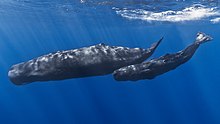
The sperm whale or cachalot (Physeter macrocephalus) is the largest of the toothed whales and the largest toothed predator. It is the only living member of the genus Physeter and one of three extant species in the sperm whale family, along with the pygmy sperm whale and dwarf sperm whale of the genus Kogia.
The sperm whale is a pelagic mammal with a worldwide range, and will migrate seasonally for feeding and breeding. Females and young males live together in groups, while mature males (bulls) live solitary lives outside of the mating season. The females cooperate to protect and nurse their young. Females give birth every four to twenty years, and care for the calves for more than a decade. A mature, healthy sperm whale has no natural predators, although calves and weakened adults are sometimes killed by pods of killer whales (orcas). (Full article...) -
Image 13
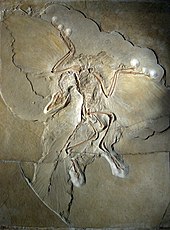
Archaeopteryx is one of the most famous transitional fossils and gives evidence for the evolution of birds from theropod dinosaurs.
A transitional fossil is any fossilized remains of a life form that exhibits traits common to both an ancestral group and its derived descendant group. This is especially important where the descendant group is sharply differentiated by gross anatomy and mode of living from the ancestral group. These fossils serve as a reminder that taxonomic divisions are human constructs that have been imposed in hindsight on a continuum of variation. Because of the incompleteness of the fossil record, there is usually no way to know exactly how close a transitional fossil is to the point of divergence. Therefore, it cannot be assumed that transitional fossils are direct ancestors of more recent groups, though they are frequently used as models for such ancestors.
In 1859, when Charles Darwin's On the Origin of Species was first published, the fossil record was poorly known. Darwin described the perceived lack of transitional fossils as "the most obvious and gravest objection which can be urged against my theory," but he explained it by relating it to the extreme imperfection of the geological record. He noted the limited collections available at the time but described the available information as showing patterns that followed from his theory of descent with modification through natural selection. Indeed, Archaeopteryx was discovered just two years later, in 1861, and represents a classic transitional form between earlier, non-avian dinosaurs and birds. Many more transitional fossils have been discovered since then, and there is now abundant evidence of how all classes of vertebrates are related, including many transitional fossils. Specific examples of class-level transitions are: tetrapods and fish, birds and dinosaurs, and mammals and "mammal-like reptiles". (Full article...) -
Image 14Cast of skull at the Natural History Museum of the University of Pisa
Livyatan is an extinct genus of macroraptorial sperm whale containing one known species: L. melvillei. The genus name was inspired by the biblical sea monster Leviathan, and the species name by Herman Melville, the author of the famous novel Moby-Dick about a white bull sperm whale. Herman Melville often referred to whales as "Leviathans" in his book. It is mainly known from the Pisco Formation of Peru during the Tortonian stage of the Miocene epoch, about 9.9–8.9 million years ago (mya); however, finds of isolated teeth from other locations such as Chile, Argentina, the United States (California), South Africa and Australia imply that either it or a close relative survived into the Pliocene, around 5 mya, and may have had a global presence. It was a member of a group of macroraptorial sperm whales (or "raptorial sperm whales") and was probably an apex predator, preying on whales, seals and so forth. Characteristically of raptorial sperm whales, Livyatan had functional, enamel-coated teeth on the upper and lower jaws, as well as several features suitable for hunting large prey.
Livyatan's total length has been estimated to be about 13.5–17.5 m (44–57 ft), almost similar to that of the modern sperm whale (Physeter macrocephalus), making it one of the largest predators known to have existed. The teeth of Livyatan measured 36.2 cm (1.19 ft), and are the largest biting teeth of any known animal, excluding tusks. It is distinguished from the other raptorial sperm whales by the basin on the skull spanning the length of the snout. The spermaceti organ contained in that basin is thought to have been used in echolocation and communication, or for ramming prey and other sperm whales. The whale may have interacted with the large extinct shark megalodon (Otodus megalodon), competing with it for a similar food source. Its extinction was probably caused by a cooling event at the end of the Miocene period causing a reduction in food populations. The geological formation where the whale has been found has also preserved a large assemblage of marine life, such as sharks and marine mammals. (Full article...) -
Image 15
Right whales are three species of large baleen whales of the genus Eubalaena: the North Atlantic right whale (E. glacialis), the North Pacific right whale (E. japonica) and the Southern right whale (E. australis). They are classified in the family Balaenidae with the bowhead whale. Right whales have rotund bodies with arching rostrums, V-shaped blowholes and dark gray or black skin. The most distinguishing feature of a right whale is the rough patches of skin on its head, which appear white due to parasitism by whale lice. Right whales are typically 13–17 m (43–56 ft) long and weigh up to 100 short tons (91 t; 89 long tons) or more.
All three species are migratory, moving seasonally to feed or give birth. The warm equatorial waters form a barrier that isolates the northern and southern species from one another although the southern species, at least, has been known to cross the equator. In the Northern Hemisphere, right whales tend to avoid open waters and stay close to peninsulas and bays and on continental shelves, as these areas offer greater shelter and an abundance of their preferred foods. In the Southern Hemisphere, right whales feed far offshore in summer, but a large portion of the population occur in near-shore waters in winter. Right whales feed mainly on copepods but also consume krill and pteropods. They may forage the surface, underwater or even the ocean bottom. During courtship, males gather into large groups to compete for a single female, suggesting that sperm competition is an important factor in mating behavior. Gestation tends to last a year, and calves are weaned at eight months old. (Full article...)
Selected picture

A dolphinarium is an aquarium for dolphins. The dolphins are usually kept in a large pool, though occasionally they may be kept in pens in the open sea, either for research or for public performances. Some dolphinariums consist of one pool where dolphins perform for the public (such as above at Loro Parque), others have expanded into much larger parks, keeping other marine animals and having other attractions.
More on dolphinariums
More did you know...

- ...common dolphins, which are often seen off South Africa’s east coast, can occur in schools of several thousand. The biggest school on record was estimated to consist of about 15,000 dolphins!
- ...because whales and dolphins are streamlined to swim in water, they do not have external organs. This makes it almost impossible to tell the sex of a whale or dolphin when watching them on the sea surface.
- ...there are probably types of cetaceans that are as yet unknown. For example, the Longman's beaked whale is only known from skulls washed ashore in Somalia and Australia. It has never been seen alive!
- ...in baleen whales females are bigger than males, while in the toothed whales the males are bigger than females.
- ...the open mouth of an adult southern right whale can be two metres wide!
Things you can do..
|
|
Here are some Cetaceans WikiProject tasks you can do.
|
General images - load new batch
-
Image 2World population graph of blue whales
-
Image 3The skeleton of a bowhead whale with the hind limb and pelvic bone structure circled in red. This bone structure stays internal during the entire life of the species. (from Evolution of cetaceans)
-
Image 4Possible relationships between cetaceans and other ungulate groups. (from Evolution of cetaceans)
-
Image 5Archaeomysticetes, like Janjucetus, had teeth.
-
Image 6Humpback whale illustration
-
Image 7Humpback whales lunge-feeding in the course of bubble net fishing
-
Image 8Spectrogram of dolphin vocalizations. Whistles, whines, and clicks are visible as upside down V's, horizontal striations, and vertical lines, respectively. (from Toothed whale)
-
Image 9Female right whale with calf
-
Image 10A protest against Japan's scientific whaling
-
Image 11Fossil of Squalodon (from Toothed whale)
-
Image 12Atlantic white-sided dolphin caught in a drive hunt in Hvalba on the Faroe Islands being taken away with a forklift (from Toothed whale)
-
Image 13Sei whale illustration
-
Image 14Baleen whales vary considerably in size and shape, depending on their feeding behavior. (from Baleen whale)
-
Image 15Eden's whale illustration
-
Image 16Diagram illustrating sound generation, propagation and reception in a toothed whale. Outgoing sounds are red and incoming ones are green (from Toothed whale)
-
Image 17Bowhead whale illustration
-
Image 18The nose of the whale is filled with a waxy substance that was widely used in candles, oil lamps, and lubricants (from Toothed whale)
-
Image 19South Atlantic right whale illustration
-
Image 21North Atlantic right whale illustration
-
Image 22Antarctic minke whale illustration
-
Image 23Bryde's whale (rorqual) (from Baleen whale)
-
Image 25Pakicetus attocki skeleton (from Evolution of cetaceans)
-
Image 26Species of the infraorder Cetacea (from Evolution of cetaceans)
-
Image 27Dolphins (aquatic mammals) and ichthyosaurs (extinct marine reptiles) share a number of unique adaptations for fully aquatic lifestyle and are frequently used as extreme examples of convergent evolution (from Evolution of cetaceans)
-
Image 28A humpback whale skeleton. Notice how the jaw is split into two.
-
Image 29A phylogenetic tree showing the relationships among cetacean families. (from Evolution of cetaceans)
-
Image 31The heart of a blue whale with a person standing next to it
-
Image 32Pygmy right whale illustration
-
Image 33Fin whale illustration
-
Image 35Archaeocetes (like this Basilosaurus) had a heterodont dentition (from Evolution of cetaceans)
-
Image 37Common minke whale illustration
-
Image 38Orange whale lice on a right whale
-
Image 39A whale as depicted by Conrad Gessner, 1587, in his Historiae animalium (from Toothed whale)
-
Image 40Gray whale illustration
-
Image 41Their eyes are relatively small for their size.
-
Image 47Blue whale illustration
-
Image 48An orca by the name of Ulises performing at SeaWorld, 2009 (from Toothed whale)
Did you know (auto-generated)

- ... that one can swim with humpback whales in the Niue Nukutuluea Multiple-Use Marine Park?
- ... that the South Asian river dolphin is nearly blind and relies on echolocation for navigation?
- ... that one of the first researchers to propose dolphin-assisted therapy for humans later renounced it?
- ... that Celia Kaye won the Golden Globe Award for Most Promising Newcomer in 1965 for her starring role in Island of the Blue Dolphins?
Selected media

Problems playing these files? See media help.
List articles
Related portals
WikiProjects

The content you are reading was created by Knowledge (XXG) volunteers. See WikiProject Cetaceans for more.
- See also: Wikispecies, a Wikimedia project dedicated to the classification of species.
Cetacean articles
Categories
For additional lists of marine life-related featured articles and good articles see:
Associated Wikimedia
The following Wikimedia Foundation sister projects provide more on this subject:
-
Commons
Free media repository -
Wikibooks
Free textbooks and manuals -
Wikidata
Free knowledge base -
Wikinews
Free-content news -
Wikiquote
Collection of quotations -
Wikisource
Free-content library -
Wikispecies
Directory of species -
Wikiversity
Free learning tools -
Wikivoyage
Free travel guide -
Wiktionary
Dictionary and thesaurus

